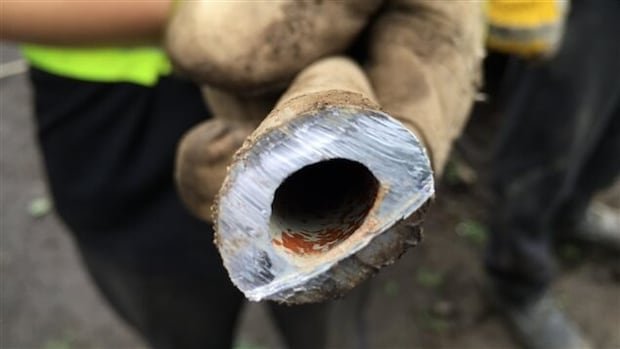Kevin Duke says replacing the lead pipes in his home doesn’t seem feasible.
The senior from Thunder Bay, Ontario, was unaware of lead pipes until the City of Thunder Bay began distributing NSF/ANSI-53 approved pipes. water filter pitcher kits in 2020. A couple of years ago, he said, the city replaced the main water line on his side of the street, but from there to his water meter, it’s all lead pipe.
“I highly doubt I can afford to replace all of that,” Duke said.
Before the mid-1950s, lead service pipes were commonly used to connect homes to city water mains. But as research emerged into the dangers of the toxic metal to people’s health, Canada’s National Plumbing Code banned lead pipes in 1975 and lead solder in 1986.
Still, many older homes across the country have lead pipes. Earlier this month, the Canadian Environmental Law Association (CELA) released a report calling on Ontario municipalities to stop only partially replacing lead service lines.
“There can be really high levels of lead in the months and years after partial replacement because the lead line has been broken and large particles can enter your home,” said Julie Mutis, CELA community outreach worker and lead author of the report.
The association recommends that cities pass bylaws requiring property owners to replace lead pipes on their side of the property line, while also providing income-adjusted financial support to help cover the costs.
“When they find the lead pipe, they won’t just take out the city side and then leave the other side of the city. [pipe] “They are in place to continue harming people, but they would be taking it all away at once,” Mutis said.
“This would mean that people who really don’t know they have lead pipes will be supported to remove them.”
Hamilton is the only municipality in Ontario that has an ordinance aimed at preventing the partial replacement of lead service lines. Mutis said several communities in Quebec and Saskatchewan already have similar bylaws; Saskatoon, for example, is on track to have all lead service lines replaced by 2029.
There can be really high levels of lead in the months and years after partial replacement because the lead line has been broken and large particles can enter your home.– Julie Mutis, Community Outreach Worker, Canadian Environmental Law Association
In Thunder Bay, the city offers an interest-free loan program as well as a $1,500 grant for eligible low-income and seniors. However, Duke wonders if that’s enough.
“I think they should be based on household income and how much it will cost to do it in that house,” he said. “I realize it would probably be a little complicated, but they should be able to do something.”
$350 million class action lawsuit underway
Corrosion control programs are one way to address the lead problem, but they are not always effective. In 2018, the City of Thunder Bay introduced a small amount of sodium hydroxide into the water supply to help. Reduce the amount of lead that leaks from old pipes.
After the chemical was added, people began complaining about small leaks in their copper pipes and hundreds of homeowners began experiencing flooding. The city phased out sodium hydroxide in early 2020, which is when it began providing NSF/ANSI-53 approved water pitchers and filters to properties with known lead service lines.

Later that year, Thunder Bay resident Patsy Stadnyk filed a $350 million lawsuit against the city on behalf of everyone affected by the leaks. It seeks compensation to cover all residents, businesses and organizations whose pipes were damaged, or at risk of damage or failure, due to the city’s introduction of sodium hydroxide into the water supply.
The city defends itself in the case. None of the allegations have been proven in court.
David O’Connor, a partner at the Toronto-based law firm Roy O’Connor LLP, is representing the plaintiff. He said the case has not yet reached the discovery stage, but he expects to see a pretrial scheduled for late next year and the matter resolved by the end of 2026.
a smaller $350,000 lawsuit against the city The lawsuit related to the leaks has since been stayed, as the plaintiff opted to be part of the class action lawsuit.
‘Lead is even more dangerous than we thought’
There are about 5,586 publicly owned and 7,818 privately owned lead service lines connected to Thunder Bay’s water distribution system, according to the city’s 2024 annual drinking water quality report.
According to the CELA report, even small amounts of lead exposure have been linked to life-altering effects, especially among children. These include:
- Reduced IQ.
- Learning difficulties.
- Behavior problems.
- Impacts on the development of fine motor skills.
“As the years go by, we learn that lead is even more dangerous than we thought, and it is important that we do not fall behind the best practices used in the rest of the country,” Mutis said.

A spokesperson for the city of Thunder Bay said they were “currently unable to conduct interviews” about lead. Instead, they provided an emailed statement to CBC News and highlighted how the city has committed $25 million over a 20-year period to replace lead service lines.
The city continues to replace publicly owned lead lines as other infrastructure work is completed, such as water main replacements and during capital renovation projects, it says. People can also request the priority lead replacement program that the city replace public property lines on its streets.
Find an affordable solution
Count. Andrew Foulds introduced the resolution for Thunder Bay Council to consider the loan and grant program to support the replacement of privately owned lead service lines. He questions whether making these replacements mandatory is in the community’s best interest.
“The question is: do you want a punitive measure? [strategy] Or do you want to encourage? And what I’m really not interested in is forcing homeowners who are already on the sidelines to suffer undue financial hardship,” Foulds said.

“How can we make our financial incentives more accessible and equitably distributed among citizens?”
By the end of 2024, the city had approved 118 interest-free loan applications for residents replacing privately owned lead pipes.
“The challenge is that completely solving this problem would cost an extraordinary amount of money that no municipality has to do all at once,” Foulds said. “How do we implement something with that sense of urgency?”
Paul Berger, an associate professor at Lakehead University and lead organizer for Citizens United for a Sustainable Planet, said it makes sense to replace lead service lines in their entirety rather than doing partial replacements.
“I think it’s a good recommendation to have a bylaw that forces homeowners to do their half of the main line. It will increase the value of the property,” Berger said.
“But I think it’s very important that it be done with equity in mind and that the city make some accommodations to make sure it’s affordable for people.”
Another important aspect is ensuring people are well educated, he said, both about lead and the city’s plans to address it.
“People often don’t pay attention to things they don’t think affect them until suddenly, when they do, they start looking for information.”









